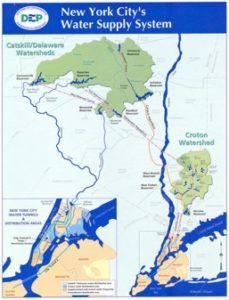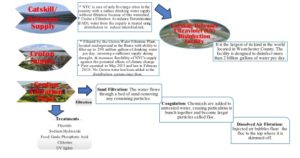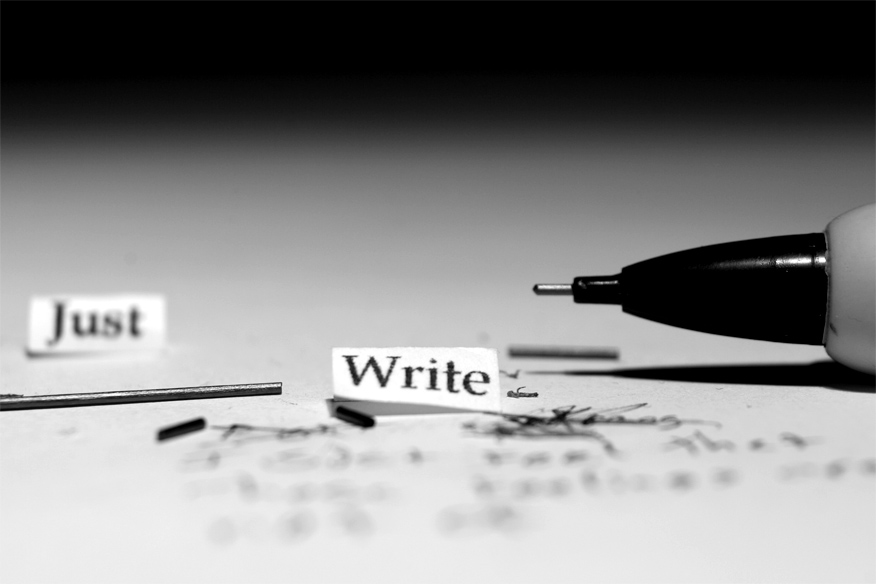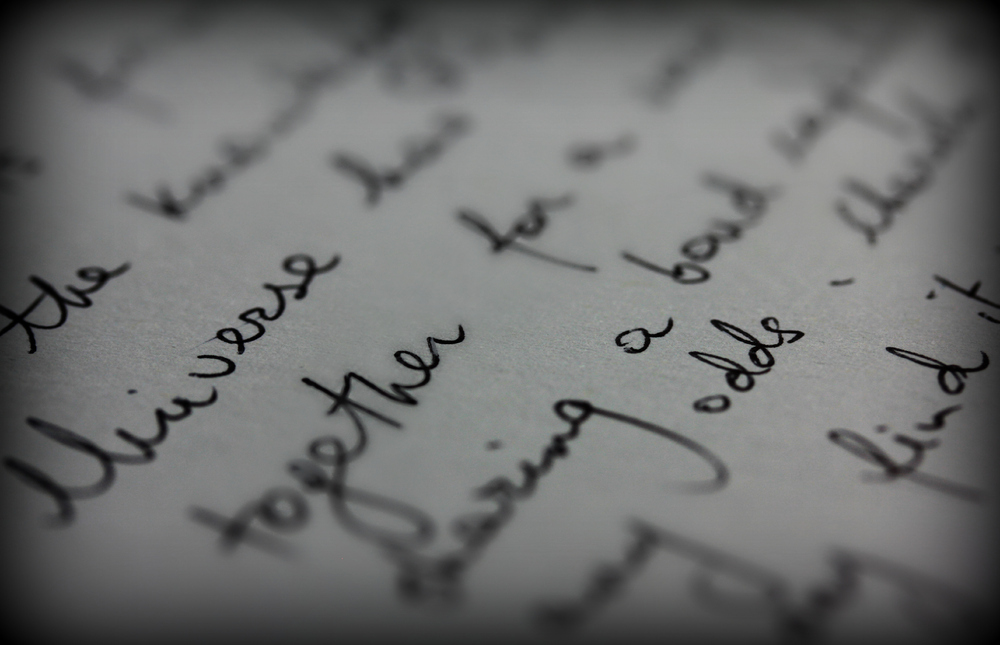
THE WATER WORLD, DNA OF LIFE: NEW YORK CITY’S DRINKING WATER
WATER SUPPLY SYSTEM
According to Vincent Sapienza, Acting Commissioner of the New York City Department of Environmental Protection (DEP), in 2017 more than one billion gallons of clean drinking water was delivered to about ten million people daily. As shown in figure 1, water distribution goes through three steps-water collection from sources, treatment and distribution. NYC drinking water comes from precipitation that fall within the watershed located in Southeastern part of New York State. This water flows to streams, and enters supply system, then gets purification treatment. Eventually water enters the storage space called reservoirs, ready for distribution. Currently, there’re 19 reservoirs and three controlled lakes in NYC water supply system with the storage capacity of 580 gallons.

Major Water Sources in New York City
Within the system, there’re three major watersheds: the Catskill/Delaware watersheds, the Croton watershed and the groundwater supply. The Catskill/Delaware watershed located in Delaware, Greene, Schoharie, Sullivan and Ulster counties provided about 97% of the water, while the Croton watershed located in Putnam, Westchester and Dutchess counties provided the rest in 2017. Because of high quality water from these two supplies, the groundwater supply in southeastern Queens remained untouched. The Catskill system was completed in 1915, including the Ashokan Reservoir and Catskill Aqueduct. Later the Schoharie Reservoir and Shandaken Tunnel were added in 1928. The Delaware system include Delaware Aqueduct completed in 1944, Rondout Reservoir in 1950, Neversink Reservoir in 1954, Pepacton Reservoir in 1955 and Cannonsville Reservoir in 1964. The initial Croton system, today known as the Old Croton Aqueduct stored 90 gallons water, so with increasing demand of increasing population, it was renewed with additional reservoirs with the name New Croton Aqueduct. The construction took place during 1985 to 1993, but service began in 1990. The detailed connection and position of each watersheds are shown in the map of the system, figure 2. Three water tunnels serve as the connection between the water supplies and distributed water to people. Tunnel one built in 1917 and tunnel two in 1936 are distributing most water to the city as tunnel three is under construction and planned to be in full service by 2020. Overall, now we get the water from two water supplies, where it gets purified and through the tunnels, water gets distributed in the five boroughs of New York City.

Water Purification Process
Since the drinking water comes from rivers, streams, and reservoirs, the surface water contains many unwanted and harmful substances along with dissolved natural minerals. Various contaminants such as radioactive, inorganic and microbial contaminants are present in the surface water. Thus, the New York State Department of Health (NYSDOH) and the United States Environmental Protection Agency (EPA) provided regulation with the specific minerals requirements in NYC drinking water. So, before reaching to the consumers, water goes through several purification processes to ensure safe, clean and high-quality drinking water. Among the major supplies, the Catskill/Delaware Supply has the best surface water quality which doesn’t require filtration. However, to get rid of microbial it goes through disinfection, which is the process of killing bacteria using specific chemicals. As mentioned in figure 3, chemicals like Chlorine (kills bacteria), Fluoride (good for dental health), Sodium Hydroxide (pH control), and Food Grade Phosphoric Acid (reducing agent of unwanted substances) are added to the water to either kill germs or to improve water quality. Also, both active water supplies have Ultraviolet (UV) Disinfection facilities where exposure to UV light deactivates dangerous microorganisms. In addition to that, Croton Water Supply has a filtration plant where sand filtration, coagulation, and dissolved air flotation take place. The detailed procedure with each additive chemicals’ functions are mentioned in figure 4.


Water Quality Monitoring
DEP constantly works to ensure safe drinking water supply to consumers. As a part of that, their staff monitor water in the distribution system, reservoirs, watersheds, streams, and aqueducts by collecting and analyzing data 365 days a year. There’re around 1,000 water quality street-sampling station spread around the five boroughs. DEP field scientists continuously analyze the collected water samples for pH, nutrients, microbial, and harmful chemicals. All the data are entered into a computer system, which get used to determine the quality of water, and predict the future quality of the reservoirs and water. As mentioned in 2017 water supply report by DEP, approximately 401,200 analyses were performed on 36,120 water samples in distribution system and they met the requirements of NYSDOH and EPA. Also, 213,600 analyses were conducted on 14,170 water samples collected from upstate reservoirs along with 1.2 million robotic monitoring measurements to ensure that the city gets the best water at all time.



Figure 5: DEP staffs collecting water samples from street-side sampling station and watershed, DEP scientist testing
water quality in Hawthorne laboratory. Source: New York Times.
Future Programs to Maintain High-quality Water and to Protect Watersheds
The major water supplies were precisely designed and constructed to be flexible with many interconnections, which allow continuous water supply to the people even at the time of droughts in some watershed locations. Although 95% of the water gets distributed to consumers by gravity and only 5% needs pumping, it is important to make sure that all the water collectors, reservoirs, and tunnels are under inspection and protected by various projects. A 10-year Filtration Avoidance Determination (FAD) for the Catskill and Delaware water supplies was secured in 2017, which means that the water doesn’t need filtration for 10-years. However, as a part of the FAD, DEP has determined to spend $1 billion in next 10-years to maintain high water quality along with expanding the watershed. Also, the third tunnel should be completed by 2020, will be capable of distributing water to the whole city. So, DEP will do a complete inspection of tunnel one and two, and will repair any damages. To protect the water supply system, DEP has announced the Ashokan Century Program. The $750 million program expected to be finished in 10 years will upgrade the infrastructures of the reservoir. Additionally, it covers refurbishing of the dams, water storage repairing, and upgrading valves of the reservoir. Meanwhile, DEP started working on repairing the Delaware Aqueduct Bypass Tunnel. The estimated cost is $1 billion, will be used to repair two major leaks by constructing 600 feet long tunnel below the Hudson river from Newburgh to Wappingers Falls and connecting it to existing bypass tunnel.
Water Conservation Management
DEP has implemented some water conservation plans to reduce water supply consumption by 20 million gallons per day by 2022. So, to reach the goal, it has partnered with many municipal agencies and entities. This program is called the Municipal Water Efficiency Program. DEP has partnered up with NYC Parks, and successfully saving 1.1 gallons of water per day. Also, to conserve water DEP partnered with the City College of New York (CCNY) in 2017. As a part of the program, it has been working to replace water fixtures, which will result in 11 million gallons of water conservation each year. It has already invested $200,000 on replacing 800 fixtures in ten buildings of the Hamilton Heights campus. Consequently, CCNY’s water demand has reduced by approximately 30,000 gallons per day.
Work Cited
Sapienza, V. (2017). New York City Water Supply System. Retrieved from https://www.dec.ny.gov/lands/53884.html
Ruby, Matt. (2016, March 24 Published). How New York Gets Its Water. Retrieved from https://www.nytimes.com/interactive/2016/03/24/nyregion/how-nyc-gets-its-water-new-york-101.html








One thought on “Technical Description”
This is a comment on a news post! It will accept HTML code!
You can change you can post comments from the Dashboard > Settings > Discussion.
You can Edit/Delete comments from the Dashboard > Comments.
You can also turn off the Comments/Pingbacks on any Page or Post when you are editing a Page or Post from the Discussion section of the editor (usually below the field for the body).
Comments are closed.